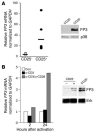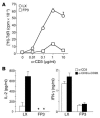The role of 2 FOXP3 isoforms in the generation of human CD4+ Tregs
- PMID: 16211090
- PMCID: PMC1242190
- DOI: 10.1172/JCI24685
The role of 2 FOXP3 isoforms in the generation of human CD4+ Tregs
Abstract
Little is known about the molecules that control the development and function of CD4+ CD25+ Tregs. Recently, it was shown that the transcription factor FOXP3 is necessary and sufficient for the generation of CD4+ CD25+ Tregs in mice. We investigated the capacity of FOXP3 to drive the generation of suppressive CD4+ CD25+ Tregs in humans. Surprisingly, although ectopic expression of FOXP3 in human CD4+ T cells resulted in induction of hyporesponsiveness and suppression of IL-2 production, it did not lead to acquisition of significant suppressor activity in vitro. Similarly, ectopic expression of FOXP3delta2, an isoform found in human CD4+ CD25+ Tregs that lacks exon 2, also failed to induce the development of suppressor T cells. Moreover, when FOXP3 and FOXP3delta2 were simultaneously overexpressed, although the expression of several Treg-associated cell surface markers was significantly increased, only a modest suppressive activity was induced. These data indicate that in humans, overexpression of FOXP3 alone or together with FOXP3delta2 is not an effective method to generate potent suppressor T cells in vitro and suggest that factors in addition to FOXP3 are required during the process of activation and/or differentiation for the development of bona fide Tregs.
Figures








References
-
- Levings MK, Bacchetta R, Schulz U, Roncarolo MG. The role of IL-10 and TGF-beta in the differentiation and effector function of T regulatory cells. Int. Arch. Allergy Immunol. 2002;129:263–276. - PubMed
-
- Sakaguchi S. Naturally arising CD4+ regulatory T cells for immunologic self-tolerance and negative control of immune responses. Annu. Rev. Immunol. 2004;22:531–562. - PubMed
-
- Shevach EM, McHugh RS, Piccirillo CA, Thornton AM. Control of T-cell activation by CD4+ CD25+ suppressor T cells. Immunol. Rev. 2001;182:58–67. - PubMed
Publication types
MeSH terms
Substances
Grants and funding
LinkOut - more resources
Full Text Sources
Other Literature Sources
Research Materials

